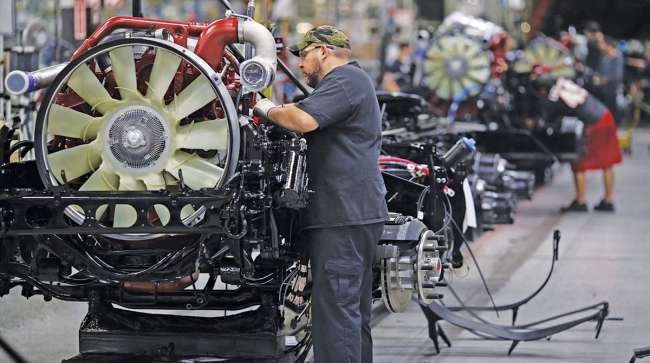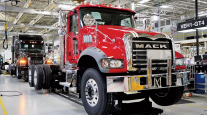Senior Reporter
December Class 8 Orders Add to Short String of Year-Over-Year Gains

[Stay on top of transportation news: Get TTNews in your inbox.]
North American Class 8 orders in December were 30,300, amplifying a trend of year-over-year gains in 2022 that began in September — the highest-ever month for orders, ACT Research reported.
ACT cited truck makers’ preliminary data. Final data is due later this month.
A year earlier, orders were 22,800, according to ACT.
Orders each month in 2022 had remained below year-over-year levels until September’s record. They then fell back from the peak but continued to improve on 2021 to close out the year.

Tam
“To be honest, I was expecting something in the mid-20,000s, so this is a high-side surprise,” said ACT Vice President Steve Tam, who acknowledged he was “more pessimistic about the supply chain situation and the truck makers’ ability to overcome the challenges to the degree they appear to think they can.”
He said December’s actual number, from a demand perspective, underscores “we are still working at sating pent-up demand” largely for replacement.
The industry views the North American Class 8 replacement level at 20,000 units per month.
Preliminary NA Class 8 net orders in December were 30,300 units, while NA Classes 5-7 net orders were 17,700 units. Complete industry data for December, including final order numbers, will be published by ACT Research in mid-January.https://t.co/EC2t4SbDnV pic.twitter.com/JPP2uiidoU — ACT Research (@actresearch) January 5, 2023
FTR pegged December orders at 28,300 and put orders for the past 12 months at 302,000.
“Backlogs are still elevated, but not at such a level that they can sustain significant deterioration without impacting production output,” said Jonathan Starks, CEO at FTR.
He noted essentially all the production slots for the first half of the year are full, and the second half is starting to fill up as well.

Starks
“The heavy-vehicle market remains strong despite economic and financial uncertainties, and production will still be limited to some extent by supply chains and labor,” Starks added.
The December volume also indicates the truck makers’ increasing level of comfort as they continue to put troublesome supply chain issues behind them, Tam said. They also have better visibility into how the year is likely to progress and so opened up more build slots and accepted more orders.
“That would be not only on the materials side but also on the labor front,” he said. “Maybe for the truck makers labor is not an issue, but when you get down into that second tier of the supply base, the competition for labor is pretty fierce at this point.”

What is the outlook for trucking in 2023? How will the industry change with the current government, economic and business trends? Join host Michael Freeze and TT reporters Eugene Mulero and Connor Wolf. Hear the program above and at RoadSigns.TTNews.com.
Tam added that in mid-2014 there was a collapse in global commodities that triggered a mini U.S. recession.
One of the outcomes was truck makers made a concerted effort to vet all levels of their supply chain. They came out of that exercise with a “very good handle” on the supply chain’s sourcing and had contingency plans in place “if branches get broken off the tree,” he said.
More recently, COVID-19 was unprecedented, and the same confident conversations are reaching him now, Tam said. “I hope that the lesson they take away is that this is not a one-and-done type of exercise. It’s something that needs to be maintained and revisited on a recurring basis.”
Also, ACT noted one truck maker group’s cancellations in December reflected incorrect historical reporting and was simply a housekeeping issue.
“Unfortunately, that kind of stuff happens. It’s not a market situation, at all,” Tam said.
Meanwhile Cowen’s fourth-quarter motor carrier survey, noted:
- 53% of carriers ordered new Class 8 trucks in the past 12 months, roughly in line with results from a quarter ago. Despite easing chip supply, shortages of spare parts continue to impede OEM manufacturing. We continue to hear that carriers are seeing little improvement in obtaining equipment with some not expecting resolution even in 2023.”
- “We asked survey participants about the size of their new Class 8 orders (above normal replacement Class 8s) as a percentage of their total fleet size (1-10% of the carrier’s total fleet size, 11-20% of the carrier’s total fleet size, etc.). Answers in this quarter’s survey were 6%, below last quarter. This is significantly below the survey’s average of 11%.”
- “Among survey participants who haven’t ordered new Class 8’s (above normal replacement levels), 48% answered that they haven’t ordered simply because they have no need for new Class 8s, below last quarter’s results. Twenty-two percent answered that they have a need, but due to economic or geopolitical uncertainty, they refrained. Lastly, 30% of participants answered ‘Other’, up from 18% from last quarter.”
The survey participants accounted for 11,000 Class 8 trucks — 30% of the survey had 1-25 trucks, 24% had 26-50 trucks, 14% had 51-75 trucks, 8% had 76-100 trucks, 15% had 101-250 trucks and 9% had 251 or more.
Cowen is a New York-based investment bank.
Want more news? Listen to today's daily briefing below or go here for more info:




